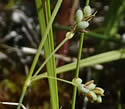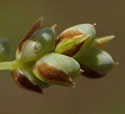Carex garberi (Elk Sedge)
| Also known as: | Garber's Sedge |
|---|---|
| Genus: | Carex |
| Family: | Cyperaceae (Sedge) |
| Life cycle: | perennial |
| Origin: | native |
| Status: |
|
| Habitat: | part shade, sun; wet sandy, gravelly or marly soils; shores, fens |
| Fruiting season: | June - August |
| Plant height: | 4 to 16 inches |
| Wetland Indicator Status: | GP: FACW MW: FACW NCNE: FACW |
| MN county distribution (click map to enlarge): |  |
| National distribution (click map to enlarge): |  |
Pick an image for a larger view. See the glossary for icon descriptions.
Detailed Information
Spikes: 

![[photo of spike clusters]](/udata/r9ndp23q/pd3/carex-garberi-062217-23-t.jpg) Three to 6 spikes, erect to ascending, cylindric, the terminal spike up to ¾ inch long, staminate (male) at the base and pistillate (female) at the tip (gynecandrous), rarely all-staminate. Lateral spikes are all-pistillate, the uppermost erect, stalkless or short-stalked, near the terminal spike but not tightly crowding it. Lower pistillate spikes are longer-stalked and erect to ascending to nodding. Pistillate spikes each have a leaf-like bract at the base of the stalk, the lower bract(s) usually over-topping the terminal spike.
Three to 6 spikes, erect to ascending, cylindric, the terminal spike up to ¾ inch long, staminate (male) at the base and pistillate (female) at the tip (gynecandrous), rarely all-staminate. Lateral spikes are all-pistillate, the uppermost erect, stalkless or short-stalked, near the terminal spike but not tightly crowding it. Lower pistillate spikes are longer-stalked and erect to ascending to nodding. Pistillate spikes each have a leaf-like bract at the base of the stalk, the lower bract(s) usually over-topping the terminal spike.
Leaves and stems: 


Leaves are alternate on the lower stem, 1 to 3.5 mm wide, often over-topping the flowering stem, hairless, V-shaped when young becoming flat. Stem leaf sheaths are membranous on the front and concave at the tip. Bases are wrapped in a brown sheath that is not fibrous. Stems are slender, 3-sided, rough along the angles on the upper stem, mostly erect to ascending; some may elongate up to 16 inches at maturity. Stems may be single but more typically found in loose clumps.
Fruit: 
![[close-up of maturing spike]](/udata/r9ndp23q/grass/carex-garberi-062417-1-t.jpg) Fruit develops in late spring through mid-summer, the pistillate spikes forming clusters of seeds (achenes), each wrapped in a casing (perigynium), subtended by a scale. Staminate scales are medium to dark brown with a pale or green midvein, whitish edging, and are blunt to pointed at the tip. Pistillate spikes are typically crowded on the stalk, with 9 to 30 fruits, and the perigynia ascending to spreading
Fruit develops in late spring through mid-summer, the pistillate spikes forming clusters of seeds (achenes), each wrapped in a casing (perigynium), subtended by a scale. Staminate scales are medium to dark brown with a pale or green midvein, whitish edging, and are blunt to pointed at the tip. Pistillate spikes are typically crowded on the stalk, with 9 to 30 fruits, and the perigynia ascending to spreading
![[photo of perigynia, scale and achene]](/udata/r9ndp23q/grass/carex-garberi-062417-2-t.jpg) Pistillate scales
are appressed to slightly spreading away from the perigynia, oval to egg-shaped, brown to dark purple-brown with a green or pale midrib, blunt to pointed at the tip, awnless, and about as wide as and as long as the perigynia or nearly so.
Perigynia
are whitish to pale green at maturity, 2 to 3 mm long, 1.2 to 1.8 mm wide, weakly many-veined, hairless, oval-elliptic in outline, loosely wrapping the achene, rounded at the base and the tip, beakless but often with a stub of the style persisting at the top.
Achenes
are 1.4 to 2 mm long, lens-shaped, round to elliptic in outline, and dark brown at maturity.
Pistillate scales
are appressed to slightly spreading away from the perigynia, oval to egg-shaped, brown to dark purple-brown with a green or pale midrib, blunt to pointed at the tip, awnless, and about as wide as and as long as the perigynia or nearly so.
Perigynia
are whitish to pale green at maturity, 2 to 3 mm long, 1.2 to 1.8 mm wide, weakly many-veined, hairless, oval-elliptic in outline, loosely wrapping the achene, rounded at the base and the tip, beakless but often with a stub of the style persisting at the top.
Achenes
are 1.4 to 2 mm long, lens-shaped, round to elliptic in outline, and dark brown at maturity.
Notes:
Carex garberi is a very rare sedge in Minnesota. According to the DNR, it was first collected from a single location in 1947 in St. Louis County, by the famed botanist (and prolific collector) Olga Lakela, but later attempts to relocate that population came up empty. It was not seen again in the state until 1992, when it was found in an extensive fen complex in Kittson County. Botanical surveys have since discovered one other population along the north shore of Lake Superior, one near Babbitt, and apparently somewhere in Koochiching County as well, but there is no information regarding that find. It is rare in most of its US range and was listed as a MN Threatened species in 1996; it is also currently Threatened in Wisconsin.
Carex is a large genus, with over 600 species in North America and 150+ in Minnesota alone. They are grouped into sections, the species in each group having common traits. Carex garberi is in the Bicolores section; some of its common traits are: clump forming, rhizomatous, basal sheaths not fibrous, leaves V-shaped in cross-section when young, leaves hairless, 2 to 6 spikes, terminal spike all staminate or with pistillate flowers at the tip (gynecandrous), lateral spikes all pistillate and usually stalked, bracts leaf-like, perigynia hairless, generally oval-elliptic, weakly veined, beakless or short-beaked, achenes lens-shaped with 2 stigmas, growing in moist, open areas.
Carex garberi is one of the two members of the Bicolores section in Minnesota, the other being the much more common Carex aurea. C. garberi is distinguished from other Carex species by the combination of: gynecandrous terminal spike, oval-elliptic and beakless perigynia generally crowded in the spike, perigynia pale green to whitish with a dense covering of minute protuberances (i.e. papillose, see photo above), pistillate scales typically dark brown and blunt to pointed at the tip, covering the perigynia or nearly so, and often appressed to the perigynia.
When mature fruit is present, C. aurea is very distinctive with its bright orange color while C. garberi is pale green to whitish; C. aurea perigynia also lack the papillose surface, are often (not always) more loosely arranged on the spike, pistillate scales are only half or so as long as the perigynia, slightly spreading not appressed, and sometimes short-awned especially near the base of a spike. The gynecandrous terminal spike, dark brown scales and pale green perigynia of C. garberi resemble a diminutive form of Carex buxbaumii, with which it may grow, but the latter is a much taller plant (to 30 inches), has scales (both staminate and pistillate) that all have a long taper to a sharply pointed tip, perigynia is up to 4 mm long, blue-green turning brown at maturity, and basal sheaths are purplish and fibrous.
Native Plant Nurseries, Restoration and Landscaping Services ↓
More photos
Photos by Peter M. Dziuk taken in Kittson County.
Comments
Have you seen this plant in Minnesota, or have any other comments about it?







 Carex garberi plant
Carex garberi plant Carex garberi plant
Carex garberi plant more spikes
more spikes